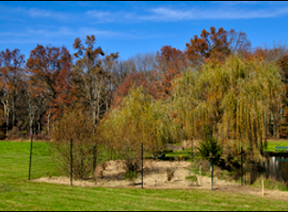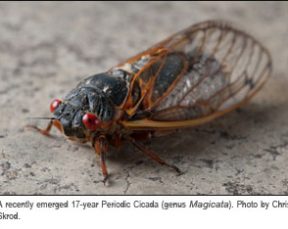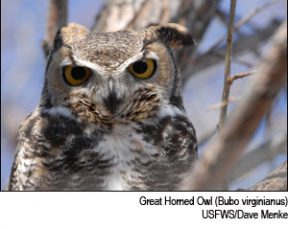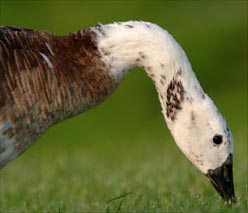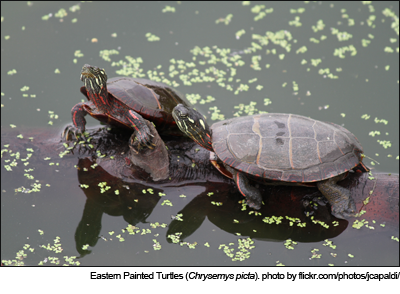

Around a bend in the boardwalk, I saw a partly submerged tree stump with what appeared to be a turtle sunning himself. I went closer and realized there were two turtles, and they were only a few feet from the boardwalk. On closer inspection, I saw that they were eastern painted turtles (Chrysemys picta), and both of them were asleep, basking in the pleasant rays of the sun.
In general, turtles seem to love soaking up sunlight. It is said that this helps to warm them up, since they are cold blooded. Basking also gets rid of parasites, such as leeches, which don’t like the sun.
Suddenly, I heard a voice. Startled, I realized that the nearest turtle had opened his eyes and was speaking to me.
“I bet you wish you had a swim club as nice as ours,” the near turtle said. I had to agree, but I realized there is more to life than sun bathing, so I had some questions.
“What do you do when you get hungry?” I asked. Well, he shared with me a rather extensive answer: “A turtle’s diet varies greatly, depending on what is conveniently available. Adult turtles like me typically eat aquatic plants like duckweed, algae, and water lilies. We also eat insects, snails, earth worms, leeches, crayfish, tadpoles, frogs, fish, and some kinds of dead animal matter. However, my turtle youngsters tend to be carnivorous — meat-eating. I am no scientist, but I suppose they instinctively seek the protein that meaty meals provide, so their young bodies will grow fast.”
At that point, the other turtle began to stir and listen to our conversation. I was curious about where and what they called “”home,” so I asked them. The second turtle stretched his neck toward the large shell on his back and said, “You’re looking at my house — this cumbersome shell. You might say, ‘I just never do leave home.’”
I took a closer look. I could see that the upper and lower shells encasing the belly of the turtle were joined together at the sides by bony structures. I also remembered that the inner layer of a turtle’s shell is made up of about 60 bones that include portions of the backbone and the ribs. So, I can see what this turtle meant about never being able to crawl out of his shell. Removing the shell would also remove part of his skeleton!
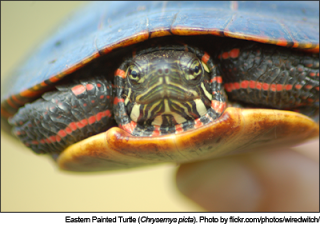

Although turtles probably spend large amounts of their lives under water, all turtles breathe air and must surface at regular intervals to refill their lungs.
Now that my friends had become so chatty, I was concerned about whether they had predators in the Great Swamp. I knew that when a turtle senses danger, it will quickly dive into the water. Also, turtles can hide their heads inside their shells when attacked by predators. But, both were quick to tell me that indeed they do have predators. The first turtle began listing a few: herons, raccoons, larger turtles, crows, large fish, snakes, hawks, bullfrogs, and foxes.
I knew it was a delicate question, but I wondered how challenging it was for turtles to reproduce. My new friends were prepared to talk about it. They said that painted turtles breed in the spring, and that females dig their nests sometime between May and July. First a female will climb a little way onto the shore. Then she will dig a hole that is close enough to the water so that the bottom of the hole will have some water in it. The hole she digs will be about four inches deep. Next, she lays her eggs — large numbers of them — in the hole; each egg being about one inch long. She then fills the hole back up to hide the nest, and the eggs are left to incubate by themselves.
Painted turtles do not raise their young. But, the baby turtles will hatch, dig their way out of the nest, and head for the water at about 10 weeks. “Sadly,” the two turtles said, “many predators will eat the baby turtles while they are so vulnerable.”
While the two turtles continued to talk, I was able to get a closer look at their mouths. Turtles have rigid beaks, and use their jaws to cut and chew food. Instead of having teeth, the upper and lower jaws of the turtle are covered by horny ridges. They apparently use their tongues to swallow food, but unlike most reptiles, they cannot stick out their tongues to catch food.
Painted turtles will not bite you if you disturb them, but they do have sharp claws. And those claws can scratch severely when a turtle struggles to get away from you. Importantly, these long, sharp claws are not used solely for defense. They are very useful when turtles clamber onto the riverbank and onto floating logs when they feel the urge to bask in the sun.
It was time for me to go, but I had one last question — I asked the two turtles what they do in the winter. They told me that they hibernate. There needs to be some mud at the bottom of the water. They dig into the mud — or dirt or leaves — and bury themselves. This posture protects them from the cold, and then their body functions slow way down until the warmer weather returns.
I thanked my two new friends for our surprising conversation, and I headed further out on the boardwalk. They invited me to chat again, if I were to come this way. I said I would, and then I realized that the Great Swamp is full of painted turtles that are pretty much identical. I would have to stop and talk to each and every one of them before finding these two new friends again!
